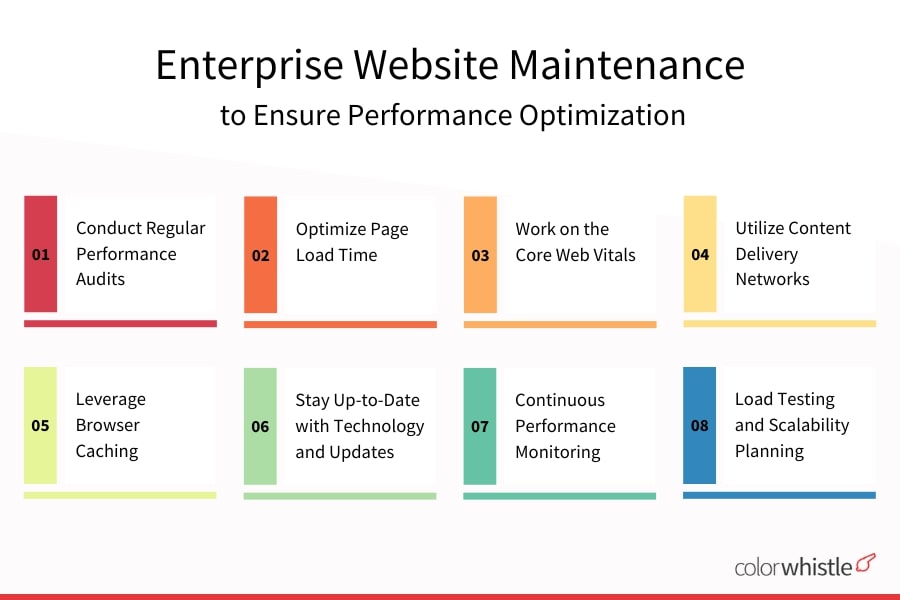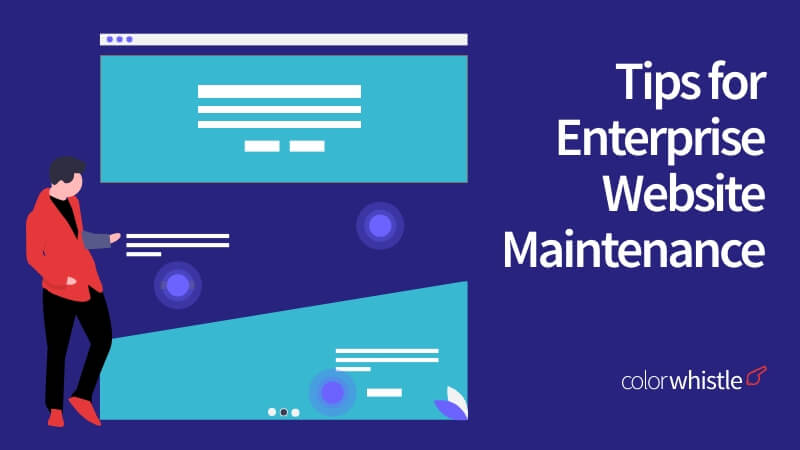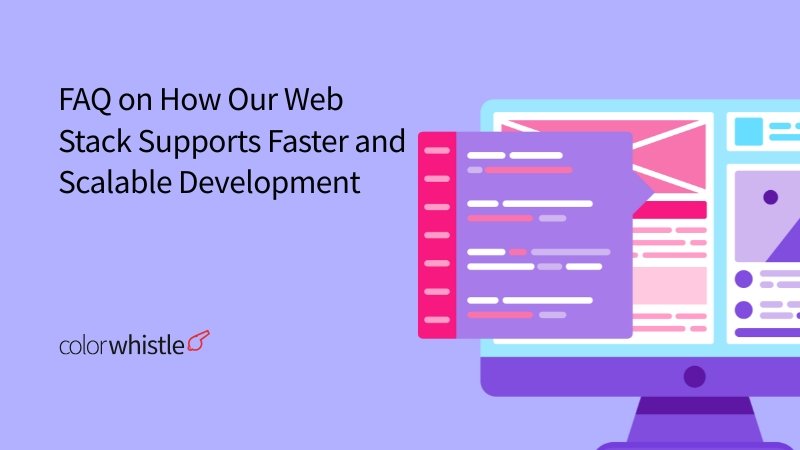Ensuring performance optimization -Tips for enterprise website maintenance are essential to achieve success in your business, as it is important to take care of your website. If your WordPress website has many files, blogs, pages, images, or videos, it needs proper attention to work well.
You must have the responsibility to check for issues like broken links, technical problems, security risks, and slow loading speed. If you miss to address these issues, you would see there is a rise in bounce rate evidently and a decrease in the number of visitors coming to your website. In this article, we are providing you with a few crucial tips that need to be considered during the maintenance of your enterprise website.
As a WordPress development company, we have invested time in exploring the tips that would be helpful for enterprise website maintenance. After several discussions with our developers (and of course, checking with ChatGPT), we have compiled this informative piece.
Delve into the details and discover the importance of website maintenance, and its metrics, and as a takeaway also read through the checklist of enterprise website maintenance.
Enjoy your reading!
Importance of Performance Optimization During Enterprise Website Maintenance
Performance optimization is of paramount importance during enterprise website maintenance. A fast and efficient website plays a crucial role in providing a positive user experience, maximizing user engagement, and driving conversions. In today’s digital landscape, where attention spans are short and competition is fierce, users expect websites to load quickly and seamlessly. Slow-loading web pages can lead to high bounce rates, decreased user satisfaction, and ultimately, loss of potential customers.
Additionally, search engines consider website speed as a ranking factor, meaning that a poorly optimized website may be pushed down in search results, resulting in reduced visibility and organic traffic. By prioritizing performance optimization as part of enterprise website maintenance, businesses can ensure that their websites deliver exceptional user experiences, improve search engine rankings, and achieve their conversion goals.
Impact of a Slow-loading Website on User Experience, Conversions, and Search Engine Rankings
A slow-loading website can have a significant negative impact on user experience, conversions, and search engine rankings. Firstly, users have little patience for slow-loading pages, and they are likely to abandon a website if it takes too long to load. This leads to a higher bounce rate and a lower engagement level, as users seek alternatives that offer faster and more responsive experiences. Secondly, slow-loading websites hinder conversions.
Users are less likely to complete desired actions, such as making a purchase or filling out a form, when they encounter delays or unresponsive elements. This can result in a decrease in sales, leads, and overall revenue generation. Lastly, search engines, such as Google, consider page load times as a ranking factor. A slow website may receive a lower ranking in search results, leading to reduced organic traffic and visibility. To mitigate these negative impacts, it is essential to prioritize performance optimization and ensure that websites load quickly and efficiently for improved user experiences, increased conversions, and enhanced search engine rankings.
Metrics for an Enterprise Website Maintenance
The metrics you choose to track will depend on your website’s goals, industry, and target audience, and here, are some important metrics to consider,
- Uptime
- Page Load Time
- Conversion Rate
- Bounce Rate
- Website Traffic
- Mobile Responsiveness
- Security Incidents
- Search Engine Rankings
- Downtime and Recovery Time
Tips for Enterprise Website Maintenance to Ensure Performance Optimization

Conduct Regular Performance Audits
Conducting regular performance audits is a crucial aspect of enterprise website maintenance. These audits comprehensively evaluate the website’s performance metrics, including page load times, server response times, and overall speed. By conducting these audits at regular intervals, businesses can identify any bottlenecks, inefficiencies, or areas for improvement that may be impacting website performance. Performance audits help uncover issues such as oversized images, excessive HTTP requests, poorly optimized code, or server configuration problems that may be slowing down the website. By addressing these issues promptly, businesses can optimize their website’s performance, resulting in faster loading times, improved user experiences, and increased conversions.
Regular performance audits also allow for tracking performance over time, ensuring that the website continues to meet industry standards and user expectations. With a proactive approach to performance optimization through regular audits, businesses can maintain a competitive edge, retain users’ interest, and achieve their online goals effectively.
Optimize Page Load Time
Optimizing page load times is essential for enhancing the user experience and driving conversions. Users expect websites to load quickly, and a delay of even a few seconds can lead to frustration and abandonment. To optimize page load times, various techniques can be employed. These include minimizing HTTP requests, optimizing images and media files, leveraging browser caching, and utilizing content delivery networks (CDNs) for faster content delivery. Additionally, optimizing code, compressing files, and prioritizing above-the-fold content can further speed up page rendering. By prioritizing page load optimization, businesses can create a seamless browsing experience, reduce bounce rates, and increase the likelihood of users staying on the website and engaging with its content.
Work on the Core Web Vitals
Core Web Vitals is a set of specific metrics identified by Google that measure the user experience of web pages, focusing on aspects such as loading, interactivity, and visual stability. These metrics include Largest Contentful Paint (LCP), which measures how quickly the main content of a page loads; First Input Delay (FID), which measures the responsiveness of a page to user interactions; and Cumulative Layout Shift (CLS), which measures the visual stability of a page.
By prioritizing and optimizing the Core Web Vitals, enterprises can ensure a better user experience and improve their search engine rankings. To work on the Core Web Vitals, businesses can optimize their website’s performance by addressing factors such as page load times, reducing server response delays, optimizing code and resource delivery, compressing images, and minimizing layout shifts. Regular monitoring, testing, and adjustments are necessary to maintain optimal Core Web Vitals performance over time.
Utilize Content Delivery Networks
Utilizing Content Delivery Networks (CDNs) is a valuable strategy for optimizing enterprise website performance. CDNs are a network of geographically distributed servers that store cached versions of website content. When a user requests a resource, the CDN delivers it from the server nearest to their location, minimizing latency and reducing the time it takes to load the content. By distributing content across multiple servers, CDNs alleviate the burden on the origin server, allowing it to focus on handling dynamic requests. This results in faster loading times, improved user experience, and increased scalability. CDNs are particularly beneficial for websites with global audiences, as they ensure consistent and fast content delivery regardless of user location. By integrating CDNs into enterprise website maintenance, businesses can effectively improve performance, reduce server load, and enhance user satisfaction.
Also Read
Leverage Browser Caching
When a user visits a website, certain elements such as images, CSS files, and JavaScript are downloaded and stored in the user’s browser cache. By setting appropriate caching headers, the website instructs the browser to store these resources locally for a specified period. Subsequent visits or requests for the same resources can then be fulfilled from the cache rather than fetching them from the server again. This significantly reduces page load times and minimizes server load. By leveraging browser caching, enterprises can enhance user experience, improve website speed, and reduce bandwidth consumption, ultimately resulting in a more efficient and faster browsing experience for users.
Managed WP Hosting and Its Advantages on Enterprise CMS Websites
Managed WordPress hosting is a specialized hosting service designed specifically for websites built on the WordPress content management system (CMS). With managed WordPress hosting, the hosting provider takes care of all the technical aspects of running a WordPress website, including server setup, security, backups, updates, and performance optimization. This allows businesses to focus on creating and managing their website’s content, rather than worrying about the technical details.
Managed WordPress hosting offers several advantages for enterprise CMS websites.
- It provides enhanced security measures specifically tailored for WordPress
- Includes automatic backups and easy restoration options, enabling businesses to quickly recover their website in case of data loss or accidental changes
- Providers typically optimize server configurations and employ caching techniques to ensure fast loading times and high performance for WordPress websites
- It allows businesses to focus on their core operations while entrusting the technical aspects of their website to professionals who specialize in WordPress hosting
Stay Up-to-Date with Technology and Updates
Technology constantly evolves, and new updates bring performance enhancements, security patches, and bug fixes. By regularly updating the website’s content management system (CMS), plugins, frameworks, and other software components, businesses can ensure optimal performance and security. Updates often introduce new features and functionalities that can enhance the user experience and streamline website operations. Moreover, staying current with technology trends allows enterprises to leverage the latest tools and techniques for performance optimization, mobile responsiveness, and search engine optimization.
Continuous Performance Monitoring
This involves actively tracking and analyzing various performance metrics to ensure the website is functioning optimally. By employing monitoring tools and services, businesses can gain real-time insights into factors like page load times, server response times, uptime, and user interactions. Continuous monitoring allows for the early detection of performance issues or bottlenecks, enabling prompt resolution and minimizing any negative impact on user experience and conversions. Regular performance monitoring helps identify trends, patterns, and potential areas for improvement, empowering businesses to make data-driven decisions to optimize their website’s performance. By proactively monitoring performance, enterprises can ensure a smooth and responsive user experience, boost customer satisfaction, and maximize the effectiveness of their online presence.
Load Testing and Scalability Planning
Load testing involves simulating heavy user traffic to assess how the website performs under stressful conditions. By conducting load tests, businesses can identify performance bottlenecks, determine the website’s capacity limits, and ensure it can handle peak traffic without compromising speed or stability. Scalability planning focuses on preparing the website for future growth by implementing strategies such as server scaling, load balancing, and optimizing resource allocation. This ensures that the website can accommodate increasing user demands without degradation in performance. By performing load testing and scalability planning, enterprises can proactively address performance issues, ensure a seamless user experience, and maintain website functionality even during periods of high traffic.
Also Read
Checklist for Enterprise Website Maintenance
Enterprise website maintenance is all about ensuring optimal performance, security, and user experience. Here’s a checklist that would guide you effectively to maintain your enterprise website and maximize its potential.
Regularly update your content: Keep your website’s content fresh and relevant so that it attracts and engages visitors, and ensures it aligns with your business objectives.
Monitor website performance: Ensure to track metrics like page load times and uptime to ensure your website is fast, reliable, and provides a smooth user experience.
Backup your website: Regularly create backups of your website’s files and databases to safeguard against data loss or website issues.
Update software and plugins: Stay up to date with the latest versions of your website’s software and plugins to ensure security, performance, and compatibility.
Check for broken links: Regularly scan your website for broken links to maintain a positive user experience and prevent negative impacts on SEO.
Optimize for mobile devices: Ensure your website is responsive and optimized for mobile devices, as an increasing number of users access the web via smartphones and tablets.
Troubleshoot your CTA buttons: Ensure that your call-to-action (CTA) buttons are free of bugs as they are essential for converting customers and generating revenue for your business. Likewise, for e-commerce businesses, it is crucial to have error-free links to shopping carts and payment gateways.
Secure your website: Implement security measures such as SSL certificates, firewalls, and regular vulnerability assessments to protect your website and user data from threats.
Test website functionality: Conduct regular tests to identify and fix any issues with website functionality, ensuring all features and forms work as intended.
Monitor website downtime: Keep an eye on website downtime and promptly address any issues to minimize disruptions and maintain high availability for users.
Optimize for search engines: Implement SEO best practices to improve your website’s visibility and ranking in search engine results, driving organic traffic and potential customers.
Improve Your Engagement with Regular Enterprise Website Maintenance
Enhancing engagement and maximizing the potential of your enterprise website requires consistent maintenance. It empowers your business and fosters trust among customers. Regularly updating content, optimizing performance, ensuring a seamless user experience, regular backups and security measures, keeping software and plugins up-to-date, optimizing for search engines and more prioritize these maintenance practices to cultivate engagement, improve user satisfaction, and drive business growth.
Ensure your website is free of errors and easily accessible to customers which would help your business to keep its growth inclined.
For more interesting and professional digital marketing services, you can contact ColorWhistle by sending us a message or call us at +1 (919) 234-5140, we’ll get back to you at the earliest. We provide services tailored to your requirements that suit your business.
What’s Next?
Now that you’ve had the chance to explore our blog, it’s time to take the next step and see what opportunities await!






